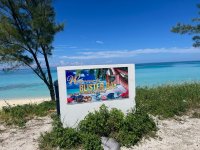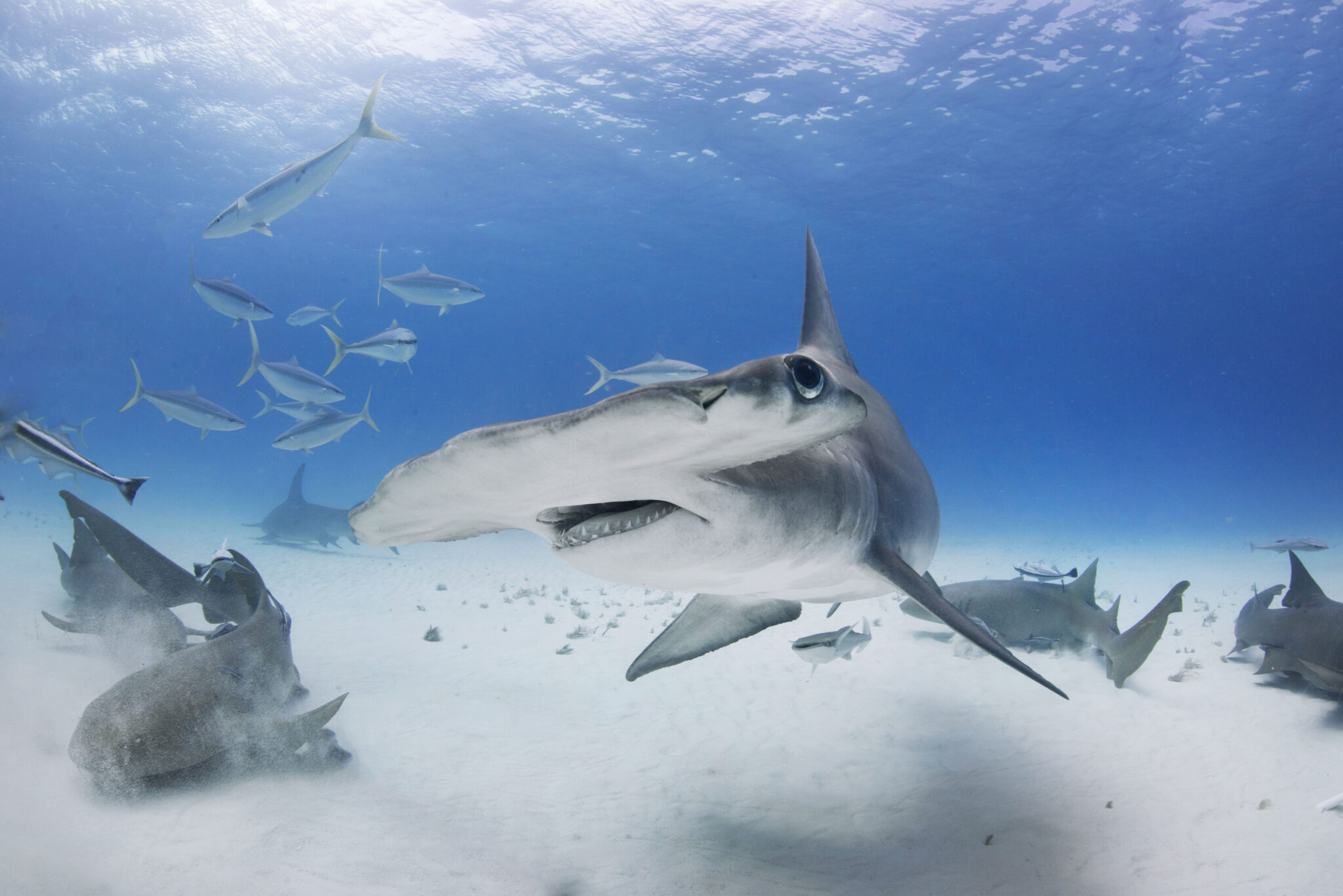ChrisC
Well-known member
I added two bucket list items to my dive resume, and both were shark-focused: Bimini and Jupiter. The sharks don't appear/migrate until December, and they leave in March. Each site has different shark species to see. (I have seen sharks - lots of Nurse and Reef Sharks, and a few Bull Sharks on Keys wrecks, but not the below).
Bimini, Bahamas - Great Hammerheads
A ferry -Balearia Caribbean (Spanish company)- runs from Ft. Lauderdale/Port Everglades to Bimini in the morning (9-11 am) and returns in the evening (4-6 pm). We stayed overnight for one PM dive, and one AM dive the following day. The advantage of a ferry is you can dive on a same-day basis versus a plane.
I had never been to Bimini before, but it's only 60 miles off the coast of Florida. Most Florida boaters will travel there in the summer (calm seas, lobster season, fishing), but winter is when the Great Hammerheads show up. Upon arrival, we rented a golf cart and headed to Bimini Big Game Club/Neal Watson's Bimini Scuba Center. North Bimini is a small island - about 11 km (7 mi) long and 200 m (700 ft) wide. Great Hammerhead Dive was scheduled for 1:30-6 pm. The dive is in about 20 ft of water; the divemaster goes down and (unfortunately) chums for the Great Hammerheads. They are almost trained to come to a spot on the island's north side for an easy dinner. Ethics aside, once a few show-up, the divers go down and hang out for 1 hr+, get another tank, and spend another 1 hr+.
We had about 5 Great Hammerheads visit in/out - sometimes circling us. It was a little unnerving when one was in front and one was in back - so I sat back-to-back with my partner to watch them. Generally, Hammerheads are not considered too aggressive to humans but exercise caution.
The sharks were impressive and majestic - about 15-18 feet long. A few Bull Sharks also showed up, but they stayed away, differing from the much larger Great Hammerheads. Everyone had underwater cameras but us. I like to just be present in my dives and screw around with expensive equipment. I was not going to test the limits of the new iPhone. I am not sure about the ethics of chumming for sharks, but it was a once-in-a-lifetime experience to see something so large in the wild. Water was still relatively warm at 76-78f, but a full wetsuit was required.
The next morning's dive was more typical Caribbean - a wall south of the island (Victory Reef) and a shallow wreck, The Sapona. Overall, the reef was very healthy - with great corals and many fish, lobsters, and crabs.
In the afternoon there was some time to tour the island - it takes just an hour to get around. There was beautiful blue water. The beaches were OK/good. We stopped at a few local Conch Shacks for conch chowder, conch salad, conch fritters, and cracked conch. Most of our US conch comes from the Bahamas.
Overall, I highly recommend diving Bimini for maybe 2 days.
Some Bimini photos.
Morning Ferry from Ft Lauderdale to Bimini

Beach - the South end of North Bimini island

Great Local Conch Shack - Im obsessed



Resorts World Manmade Beach


Southern Stingray in the Water

Another Conch Shack - Stuarts

Bimini Big Game Club docks

Nice Catamaran

Best Public Beach - Southern end of N Bimini




Great Water Colors - big cruise ship coming in

Sunset on the Ferry home: Bimini to Ft. Lauderdale

Jupiter, Florida - Lemon Sharks - Migration Season
I always knew Jupiter has the most sharks of any dive location in Florida since it sits close to the Gulfstream, but I had never been. I usually dive wrecks in Key Largo, the untouched beauty of Biscayne Bay National Park, or just off the coast of Fort Lauderdale.
In the Winter Months, the Lemon Sharks appear from December to March (not sure where they are at during the summer months)
Quick AI description:
Lemon sharks migrate south and into deeper waters in Florida during the winter months and then north in the spring. This predictable behavior makes them vulnerable to overfishing, and Florida has limited harvesting of lemon sharks in its waters.
Here are some places in Florida where you can see lemon sharks migrating:
Jupiter
From December to late March, the waters off Jupiter are home to a large aggregation of lemon sharks. The sharks follow the nutrient-rich Gulf Stream, and divers can see up to 60 sharks on a dive.
Lemon Drop
A favorite site for scuba divers, Lemon Drop, sees an influx of lemon sharks in the early months of the year.
Lemon sharks are tropical sharks with a pale lemon-brown hue to their skin. They can grow to over 13 feet long and are known for their second dorsal fin, which is almost as large as their first. They are one of the few shark species that can pump their gills to breathe and can often be found resting in the sand along the reef.
We saw about 15 Lemon sharks at two dive locations and a few Goliath Grouper. (Goliath Grouper season is typically August to October, so that was a bonus). The Lemons are about 10 feet long, making the Reef sharks look small. Supposedly, they are not a threat to humans but are still menacing looking, especially in large numbers.
After the Great Hammerheads (and Bull Sharks), the Lemon Sharks were not quite as awe-inducing, but still pretty impressive.
I highly recommend it if you dive in South Florida during the Winter. It's better than its reefs or the Keys.
Bimini, Bahamas - Great Hammerheads
A ferry -Balearia Caribbean (Spanish company)- runs from Ft. Lauderdale/Port Everglades to Bimini in the morning (9-11 am) and returns in the evening (4-6 pm). We stayed overnight for one PM dive, and one AM dive the following day. The advantage of a ferry is you can dive on a same-day basis versus a plane.
I had never been to Bimini before, but it's only 60 miles off the coast of Florida. Most Florida boaters will travel there in the summer (calm seas, lobster season, fishing), but winter is when the Great Hammerheads show up. Upon arrival, we rented a golf cart and headed to Bimini Big Game Club/Neal Watson's Bimini Scuba Center. North Bimini is a small island - about 11 km (7 mi) long and 200 m (700 ft) wide. Great Hammerhead Dive was scheduled for 1:30-6 pm. The dive is in about 20 ft of water; the divemaster goes down and (unfortunately) chums for the Great Hammerheads. They are almost trained to come to a spot on the island's north side for an easy dinner. Ethics aside, once a few show-up, the divers go down and hang out for 1 hr+, get another tank, and spend another 1 hr+.
We had about 5 Great Hammerheads visit in/out - sometimes circling us. It was a little unnerving when one was in front and one was in back - so I sat back-to-back with my partner to watch them. Generally, Hammerheads are not considered too aggressive to humans but exercise caution.
The sharks were impressive and majestic - about 15-18 feet long. A few Bull Sharks also showed up, but they stayed away, differing from the much larger Great Hammerheads. Everyone had underwater cameras but us. I like to just be present in my dives and screw around with expensive equipment. I was not going to test the limits of the new iPhone. I am not sure about the ethics of chumming for sharks, but it was a once-in-a-lifetime experience to see something so large in the wild. Water was still relatively warm at 76-78f, but a full wetsuit was required.
The next morning's dive was more typical Caribbean - a wall south of the island (Victory Reef) and a shallow wreck, The Sapona. Overall, the reef was very healthy - with great corals and many fish, lobsters, and crabs.
In the afternoon there was some time to tour the island - it takes just an hour to get around. There was beautiful blue water. The beaches were OK/good. We stopped at a few local Conch Shacks for conch chowder, conch salad, conch fritters, and cracked conch. Most of our US conch comes from the Bahamas.
Overall, I highly recommend diving Bimini for maybe 2 days.
Some Bimini photos.
Morning Ferry from Ft Lauderdale to Bimini
Beach - the South end of North Bimini island
Great Local Conch Shack - Im obsessed
Resorts World Manmade Beach
Southern Stingray in the Water
Another Conch Shack - Stuarts
Bimini Big Game Club docks
Nice Catamaran
Best Public Beach - Southern end of N Bimini
Great Water Colors - big cruise ship coming in
Sunset on the Ferry home: Bimini to Ft. Lauderdale
Jupiter, Florida - Lemon Sharks - Migration Season
I always knew Jupiter has the most sharks of any dive location in Florida since it sits close to the Gulfstream, but I had never been. I usually dive wrecks in Key Largo, the untouched beauty of Biscayne Bay National Park, or just off the coast of Fort Lauderdale.
In the Winter Months, the Lemon Sharks appear from December to March (not sure where they are at during the summer months)
Quick AI description:
Lemon sharks migrate south and into deeper waters in Florida during the winter months and then north in the spring. This predictable behavior makes them vulnerable to overfishing, and Florida has limited harvesting of lemon sharks in its waters.
Here are some places in Florida where you can see lemon sharks migrating:
Jupiter
From December to late March, the waters off Jupiter are home to a large aggregation of lemon sharks. The sharks follow the nutrient-rich Gulf Stream, and divers can see up to 60 sharks on a dive.
Lemon Drop
A favorite site for scuba divers, Lemon Drop, sees an influx of lemon sharks in the early months of the year.
Lemon sharks are tropical sharks with a pale lemon-brown hue to their skin. They can grow to over 13 feet long and are known for their second dorsal fin, which is almost as large as their first. They are one of the few shark species that can pump their gills to breathe and can often be found resting in the sand along the reef.
We saw about 15 Lemon sharks at two dive locations and a few Goliath Grouper. (Goliath Grouper season is typically August to October, so that was a bonus). The Lemons are about 10 feet long, making the Reef sharks look small. Supposedly, they are not a threat to humans but are still menacing looking, especially in large numbers.
After the Great Hammerheads (and Bull Sharks), the Lemon Sharks were not quite as awe-inducing, but still pretty impressive.
I highly recommend it if you dive in South Florida during the Winter. It's better than its reefs or the Keys.
Attachments
Last edited:


